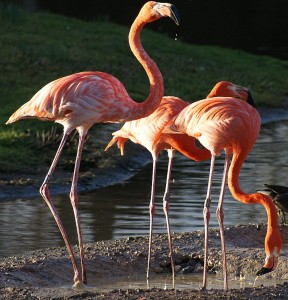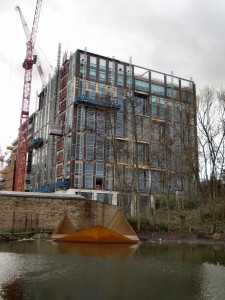The forecast offers a brief ridge of high pressure in between wind, rain and distant storms. I take my gumboots and drive down to the lakes to enjoy the unlikely burst of sunshine. Sure enough, the sky clears, the temperature plummets, and I quickly put on fleece and windproof jacket. On the main lake are three Goldeneye, the males handsome as they surface between dives. Other than them, there are few birds on the water: more come when the wind is colder and drier, from the north or east, bringing winter ducks from icy Scandinavia or further afield. A few Great-crested Grebes, some Tufted Duck more or less complete the waterfowl, barring a stray Cormorant, a Mallard or two, a lone Moorhen.
The bushes are more interesting, as a party of Long-tailed Tits, unconcerned by human presence, flutters along one after another; the light is good enough to make out their slight pinkish tinge as they dangle upside down for a few moments before drifting onwards. From a tangle on the lake’s edge comes the loud Chwit-i-pit-i-pit, Chwit-i-pit-i-pit of a Cetti’s Warbler. It sounds grand and splendid but the Cetti’s are resident and while not exactly common, are not unlikely where there are bits of wetland. But the main and most obvious concern is the path, which has disappeared under a foot of water: the river is pouring across the grass, down the path, and across into the lake, which is higher than I’ve ever seen it. I take a stick and probe carefully: gumboots are all very well, but vanishing into a hole isn’t the best move when there’s a brisk wind over chilly water and very slippery mud. About a hundred yards are flooded in all, some of it probably too deep for boots, but I skirt the edge, only ankle-deep.
Around the corner, the water is halfway up the Private Fishing sign, and another section of path is under water. I reluctantly leave the path and scramble through the bushes on what has become a small hilly causeway. Re-emerging into the sunshine, I am observed curiously by a rabbit and a squirrel. Since the wind is now in my face, they cannot catch my scent, but watch as I very slowly raise my binoculars. They are still, but alert and watchful; eventually they wander off. A Buzzard flies down the wind, hardly needing a wingbeat in the brisk airstream. The horse field is like something out of the First World War, pocked with holes, rutted with tracks, slimy with mud and dung; the farmer has installed an oddly clean new fence, all shiny wire and white wooden poles, so I am obliged to take a detour through the worst of the Flanders mud to the ugly new galvanised steel gate. Still, it is a delight to be outside in the open air and sunshine, to see what nature is up to now.
I realise I am not particularly birdwatching, nor just walking for exercise, though I’m happy to do both: I’m just staying in touch with the natural world, and feel – what? If it were food, it would be starved: I would be feeling sad and starved of the flow of nature, of the seasons, without it. Walking in flood and mud, in the breeze and sunshine, I am simply myself, with whatever nature has to offer today. If that’s pretty primroses, that’s lovely; if it’s slimy deepening mud in an exceptionally wet winter, that’s fine too. Is it Climate Change? I’ve no idea, but I’ve certainly never seen a winter like this before.


